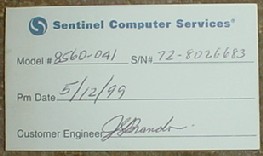IBM PS/2 Model 60

Here's a PS/2
that I'd been looking to find for a very long time. As it happens, I
actually found my first two at a nearby hamfest in 2003. Unfortunately
for me, in 2004 I woke up one morning to find my basement completely
flooded due to a sewer failure. Even more unfortunately, the two
Model 60s I had somehow slipped away in the flood. I suppose one ended
up going out to the trash, but I'm not quite sure. I still have one of
the two, but it is missing most of its exterior plastics.
I finally found
another by way of an auction pointed out comp.sys.ibm.ps2.hardware. The
auction was from a seller located in Springfield, Illinois...and the
listing promised several Model 60s, so I "bought them now". As it
turned out, only one of the systems ended up being a Model 60. The
others were a mix of models 30, 50, 55SX, 70, and 80.
Restoration
Of course, these
systems had been sitting for a long time and were very dirty.
Naturally, the CMOS batteries and hard drives were dead in some of
these systems. While looking over this Model 60, I found that it had
the latest date of use of any of the systems I ended up getting. Most
had been shelved sometime in 1995. I found a periodic maintenance tag
on it that puts the last date of use sometime in 1999. I suppose this
system was probably decommissioned not because it wasn't working well,
but rather because it was mistakenly feared to be non-year 2000
compliant.

Whoever owned this PS/2 might be interested in knowing that serial number 72-8026683 is still out there running along!
This computer
powered up fine, but showed signs of trouble from sitting around. For
starters, the floppy drive didn't work at all. Nothing I could do at
the time was able to convince it to even try to read floppies, so I put
the original drive aside and pulled one of my "spares" pile. This got
the system to the point where it would read floppy diskettes once
again. At this point I replaced the CMOS battery and ran the reference
disk to set the configuration and time/date settings. Capacitor failure
seems to be what kills these drives, although it doesn't help matters
that the drives used in the earlier PS/2 models didn't have a dust
shutter in place over the diskette opening.
Now came the
time to clean the case. PS/2 cases take pretty well to aggressive
scrubbing (although use of aggressive cleaners is generally not
recommended unless you have no other option) and this one sure needed
it. The usual asset tags were carefully removed, as was the rotting
foam from the inside of the system unit's cover. Unfortunately, the
foam that IBM used in these systems tends to rot and turn into a gummy
mess, probably due to heat and moisture exposure over the years. And of
course it must stick to everything that touches it when you are
removing it. I replaced the foam with similar stuff sold for use as
weatherstripping at Ace Hardware. It works well and seems to be a very
close match to the thin strips of foam that IBM used in thse systems.
For the thicker foam pads, I either formed a shape resembling the
original pad or left it out entirely. Once the basics had been covered,
I cleaned the exterior using a sponge with a scrubbing pad on one side
and some dish soap.
With the CMOS battery replaced, the floppy working and the casing cleaned up, the restoration was complete.
Plans
I'd really like to build this into a well equipped Model 60. I have at my disposal a few suitable memory cards, an IBM 486SLC2 processor upgrade,
8514/A adapter and an extra IBM MCA SCSI controller that I may install
someday. The original 40 megabyte MFM drive works but is feeling its
age and sometimes takes a while to come up with the requested data.
It's also rather noisy and hot running. A more modern 3.5" SCSI drive
can be easily installed with the 5.25" to 3.5" adapter cage that was
offered in some Model 80 and 65SX systems.
Back>
Copyright ©2007 by William R. Walsh. All Rights Reserved. See the complete copyright statement on the Computer Collection Index for more information on reusing this material.

